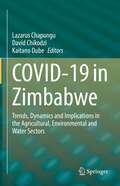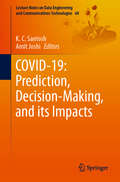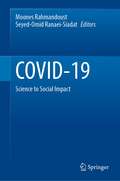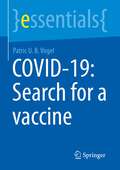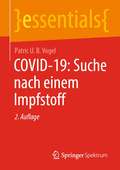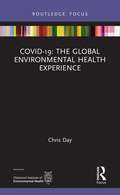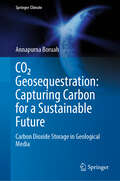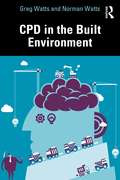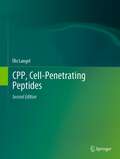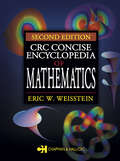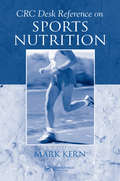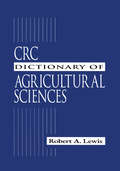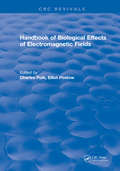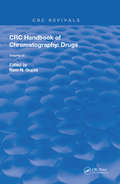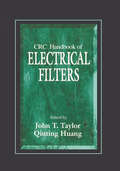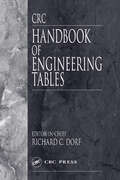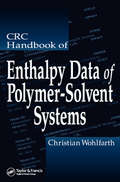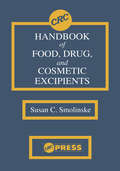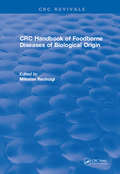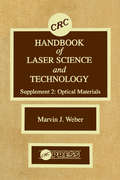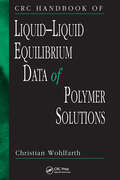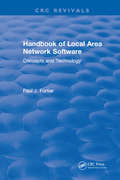- Table View
- List View
COVID-19 in Zimbabwe: Trends, Dynamics and Implications in the Agricultural, Environmental and Water Sectors
by Kaitano Dube David Chikodzi Lazarus ChapunguThis contributed volume, based on papers presented at a conference held in Zimbabwe in mid-2021, interrogates solutions to COVID-19-related problems and issues across agricultural, environmental and water sectors in Zimbabwe and assesses their scientific, economic and practical validity. Across 19 chapters, this volume unpacks the science, economics and politics of the pandemic with a focus on understanding its secondary and tertiary impact on Zimbabwe’s population. The volume is also dedicated to understanding the practical and policy-oriented approaches in tackling the pandemic and confronting the “new normal” of COVID-19. It brings together researchers, development practitioners and policy makers from various disciplines in an endeavour to understand COVID-19 trends and analyse the scientific options for mitigation, containment, innovation and ultimately pre-empt the possible emergence and impacts of other pandemics in the future
COVID-19: Prediction, Decision-Making, and its Impacts (Lecture Notes on Data Engineering and Communications Technologies #60)
by Amit Joshi K. C. SantoshThis book outlines artificial intelligence for COVID-19 issues that are ranging from prediction to decision-making for healthcare support in human lives. Starting with major COVID-19 issues and challenges, it takes possible AI-based solutions for multiple problems, such as early prediction, its role for public health, detection of positive cases, drug analysis, and healthcare support. It mainly employs publicly available data (population) to predict who should be tested for COVID-19, for example, radiological image data to detect COVID-19 positive cases from other similar and/or different manifestations, such as pneumonia, distributed healthcare support, and supply chains in the middle of COVID-19 pandemic. The book includes recently developed AI-driven tools and techniques, such as pattern recognition, anomaly detection, machine learning, and data analytics. It covers a wide range of audience from computer science and engineering to healthcare professionals.
COVID-19: Science to Social Impact
by Moones Rahmandoust Seyed-Omid Ranaei-SiadatThis book highlights the overview of the COVID-19 pandemic from both the scientific and the social perspectives. The scientific part presents key facts of COVID-19, including the structure of the virus and the techniques for the diagnosis, treatment, and vaccine development against the disease, covering state-of-the-art findings and achievements worldwide. The social part is written by WHO professionals who worked on the frontier of the fight against the disease. It covers the global security situation during the pandemic, the WHO and governmental-level risk management measures, and the estimated impact that COVID-19 will eventually create on social life after it is globally controlled.
COVID-19: Search for a vaccine (essentials)
by Patric U. VogelThis book presents the principle, strengths and weaknesses, and progress of various vaccine technologies against COVID-19. Additionally, important terms such as clinical phases, efficacy and sterilizing immunity are explained. In this second edition, the already approved vaccines are also presented and the importance of viral variants is explained
COVID-19: Suche nach einem Impfstoff (essentials)
by Patric U. VogelIn diesem Buch werden das Prinzip, die Stärken und Schwächen sowie der Fortschritt verschiedener Impfstofftechnologien gegen COVID-19 dargestellt. Es werden zusätzlich wichtige Begriffe wie klinische Phasen, Wirksamkeit und sterilisierende Immunität erklärt. In dieser zweiten Auflage werden auch die bereits zugelassenen Impfstoffe vorgestellt sowie die Bedeutung von Virusvarianten erklärt.
COVID-19: The Global Environmental Health Experience (Routledge Focus on Environmental Health)
by Chris DayThis book is devoted to the efforts of Environmental Health Practitioners (EHPs), their employers and supportive professional bodies world-wide in responding to the COVID-19 pandemic. Drawing upon the first-hand experiences and reflections of EHPs working across the professional discipline in countries around the world, the book highlights how they responded to the initial wave of SARS-CoV-2 infection as it spread globally. It explores how this impacted on their environmental health work as their wider public health skills and expertise were increasingly called upon/ The book recognises the significant contributions that EHPs have made to protect lives and livelihoods since the seriousness of COVID-19 became apparent. It also identifies shortcomings in the response and deployment of personnel and makes a series of recommendations to inform future practice. This book: Captures a moment in history through the experiences of Environmental Health Practitioners in meeting the complex challenges presented by the COVID-19 pandemic. Features the observations of front line practitioners on the practical challenges and opportunities encountered globally, suggesting the lessons learnt for current practice in infectious disease prevention and control. Expands upon the reflections of some of the professional bodies around the world as to how the response of EHPs to the COVID-19 pandemic should result in a renewed commitment to public health through Environmental Health. EHPs in current practice and in training, other public health professionals and those looking to build better health protection services, now, and in the future, will find this book a valuable resource to inform the case for the key role of Environmental Health in the current pandemic, in response to future challenges and crises, and in managing risks to health encountered in more usual times.
CO₂ Geosequestration: Carbon Dioxide Storage in Geological Media (Springer Climate)
by Annapurna BoruahAs the world faces the urgent need to combat climate change, "CO2 Geosequestration: Capturing Carbon for a Sustainable Future" provides a comprehensive solution on carbon dioxide storage in geological media, and utilization to reduce the CO2 from the atmosphere. This book serves as a guide to understanding the science and technology for carbon dioxide geosequestration. In this engaging guide, the author delves into innovative methods and processes designed to securely store CO2 emissions from various sources. With a focus on environmental sustainability, the book explores the geological storage of carbon dioxide in depleted oil and gas reservoirs, coal, shale, saline aquifers, basalt, and other underground formations, ensuring that this remains safely sequestered for the long term. Through a blend of real-world case studies, cutting-edge research, and expert insights, CO2 Geosequestration highlights the potential of this technology to mitigate greenhouse gas emissions and reduce the carbon footprint of industries worldwide. From the basics of carbon capture to the intricate details of monitoring and verification, this book offers an in-depth look at the challenges, opportunities, and prospects of CO2 geosequestration. Whether you are a scientist, engineer, policymaker, or environmentally conscious individual, this book provides a valuable resource for understanding the fundamental principles and potential benefits of geosequestration in the fight against climate change. Join us on a journey toward a sustainable future where carbon capture and geosequestration play critical roles in protecting our planet for generations to come.
CPD in the Built Environment
by Greg Watts Norman WattsThe aim of this book is to provide a single source of information to support continuing professional development (CPD) in the built environment sector. The book offers a comprehensive introduction to the concept of CPD and provides robust guidance on the methods and benefits of identifying, planning, monitoring, actioning, and recording CPD activities. It brings together theories, standards, professional and industry requirements, and contemporary arguments around individual personal and professional development. Practical techniques and real-life best practice examples outlined from within and outside of the industry empower the reader to take control of their own built environment-related development, whilst also providing information on how to develop fellow staff members. The contents covered in this book align with the requirements of numerous professional bodies, such as the Royal Institution of Chartered Surveyors (RICS), the Institution of Civil Engineers (ICE), and the Chartered Institute of Builders (CIOB). The chapters are supported by case studies, templates, practical advice, and guidance. The book is designed to help all current and future built environment professionals manage their own CPD as well as managing the CPD of others. This includes helping undergraduate and postgraduate students complete CPD requirements for modules as part of a wide range of built environment university degree courses and current built environment professionals of all levels and disciplines who wish to enhance their careers through personal and professional development, whether due to professional body requirements or by taking control of identifying and achieving their own educational needs.
CPP, Cell-Penetrating Peptides
by Ülo LangelIn this book, a summary and update of the most important areas of cell-penetrating peptides (CPP) research are presented, while raising relevant questions for further development. The CPP sequences are presented and discussed throughout the book. The methods for testing CPP mechanisms are discussed in detail. Various approaches for the testing of endocytotic pathways of CPP uptake are also described. Different CPP uptake experiments are compared since it is becoming clear that it is often best to apply several methods in a complementary manner in order to most comprehensively evaluate CPP uptake mechanisms due to the complexity of these processes. A brief summary of functionality issues of CPPs, both in vitro and in vivo, is discussed. Therapeutic potential of CPPs and commercial developments are discussed. The present, second edition of this book is the updated and expanded version of the first edition, published in 2019. The development of the field of cell-penetrating peptides in these five years has been obvious and exciting. This second edition of the book has been partly reorganized and comprehensively expanded with the exciting research in 2019-2023. Around 2500 novel scientific articles have become available, most of them are reviewed in the second edition. Additional rapidly growing areas of high impact presented in this second edition are therapeutic developments (Chapter 16) and delivery of oligonucleotides and proteins/peptides (Chapters 5 and 6) including novel reports on genome editing with CPP assistance. Also, several additional examples are available now on clinical trials using CPPs (Chapter 15). The book is written for researchers and students in the field.
CRC Concise Encyclopedia of Mathematics
by Eric W. WeissteinUpon publication, the first edition of the CRCConcise Encyclopedia of Mathematics received overwhelming accolades for its unparalleled scope, readability, and utility. It soon took its place among the top selling books in the history of Chapman & Hall/CRC, and its popularity continues unabated.Yet also unabated has been the d
CRC Desk Reference for Nutrition
by Carolyn D. BerdanierFollowing in the tradition of its popular predecessors, the CRC Desk Reference for Nutrition, Third Edition explains hundreds of terms commonly used in medicine, food science, metabolism, physiology, and nutrition. Thoroughly updated and expanded to reflect major advances over the past decade, this reference lists entries alphabetically and cross-r
CRC Desk Reference on Sports Nutrition
by Mark KernThe landscape of sports nutrition is dramatically altering, as those in search of optimal performance are moving the field from haphazard alchemy to exact science. Currently, thousands of products -- from ancient herbs and old standards to hormone extractions and test tube concoctions --compete for a place at the training table of both professional
CRC Dictionary of Agricultural Sciences
by Robert Alan LewisThis dictionary includes every area of agriculture, from traditional farming to the latest techniques in biotechnology and genetics. The dictionary provides standardized definitions that establish common ground between the various types of practitioners involved in agriculture. It defines terminology in areas such as agricultural economics and business, agroecology, agronomy, animal science, aquaculture, botany, conservation, dairy science, entomology, food science, forestry, horticulture, natural resource management, and much more.
CRC Handbook of Applied Thermodynamics
by David A. PalmerThis practical handbook features an overview of the importance of physical properties and thermodynamics; and the use of thermo-dynamics to predict the extent of reaction in proposed new chem-ical combinations. The use of special types of data and pre-diction methods to develop flowsheets for probing projects; and sources of critically evaluated data, dividing the published works into three categories depending on quality are given. Methods of doing one's own critical evaluation of literature, a list of known North American contract experimentalists with the types of data mea-sured by each, methods for measuring equilibrium data, and ther-modynamic concepts to carry out process opti-mization are also featured.
CRC Handbook of Biological Effects of Electromagnetic Fields
by Charles PolkThe objective of this book is to present in a concise manner what is actually known at the present time about biological effects of time invariant, low frequency and radio frequency (including microwave) electric and magnetic fields. In reviewing the vast amount of experimental data which have been obtained in recent years, the authors tried to select those results that are, in their opinion, of major importance and of lasting value. In discussing mechanisms of interaction of electromagnetic fields with living matter they have tried to differentiate between what is clearly established, what is suggested by available evidence without being convincingly proven, and what is conjecture at the present time.
CRC Handbook of Chromatography: Drugs, Volume VI (Handbook Of Chromatography Ser. #2)
by Ram N. GuptaThese volumes provide a reference source of different gas chro-matographic, liquid chromatographic, or thin-layer chromatographic techniques for the qualitative determination of various therapeutic agents, including antibiotics, vitamins and hormones, drugs of abuse in body fluids, dosage forms, or food stuffs. Over 5000 publi-cations were reviewed to prepare tables of chromatographic data for 800 compounds, arranged alphabetically by generic drug name or by drug groups. A detailed summary of the extraction procedure de-scribed in each publication included in the table of a particular drug is also provided. This easy-to-read handbook is useful for se-lecting an appropriate chromatographic procedure for the determi-nation of a given compound according to the available facilities.
CRC Handbook of Dietary Fiber in Human Nutrition
by Gene A. SpillerDietary fiber is widely recognized as an essential element of good nutrition. In fact, research on the use of fiber in food science and medicine is being conducted at an incredible pace. CRC Handbook of Dietary Fiber in Human Nutrition, Third Edition explores the chemistry, analytical methodologies, physiological and biochemical aspects, clinical a
CRC Handbook of Electrical Filters
by John Taylor Qiuting HuangInterest in filter theory and design has been growing with the telecommunications industry since the late nineteenth century. Now that telecommunications has become so critical to industry, filter research has assumed even greater importance at companies and academic institutions around the world. The CRC Handbook of Electrical Filters fills in the gaps for engineers and scientists who need a basic introduction to the subject. Unlike the currently available textbooks, which are filled with detailed, highly technical analysis geared to the specialist, this practical guide provides useful information for the non-specialist about the various types of filters, their design, and applications.The handbook covers approximation theory and methods and introduces CAD packages that perform approximation and synthesis for both analog and digital filters. Also included are design methods for LCR, active-RC, digital, mechanical, and switched capacitor (SC) filters. A thorough survey of current design trends rounds out this complete assessment of a key field of study.
CRC Handbook of Engineering Tables (The Electrical Engineering Handbook)
by Richard C. DorfThe most important tables from every engineering discipline in one volume collected from the best, most authoritative references in the business--it's now more than wishful thinking. The CRC Handbook of Engineering Tables makes it a reality. The most frequently consulted tables and figures from CRC's acclaimed engineering handbooks are gathered tog
CRC Handbook of Enthalpy Data of Polymer-Solvent Systems
by Christian WohlfarthThe CRC Handbook of Enthalpy Data of Polymer-Solvent Systems presents data that is as essential to the production, process design, and use of polymers as it is to understanding the physical behavior and intermolecular interactions in polymer solutions and in developing thermodynamic polymer models. Providing an all-encompassing collection
CRC Handbook of Food, Drug, and Cosmetic Excipients
by Susan C. SmolinskeCRC Handbook of Food, Drug, and Cosmetic Excipients provides a comprehensive summary of toxicological issues regarding inactive ingredients in pharmaceutical products, cosmetic products, and food additives. Background information on regulations and labeling requirements for each type of product is provided, and 77 articles critically review human and animal data pertinent to a variety of agents and makes judgments regarding the clinical relevance. The book also identifies at-risk populations, such as neonates, patients with renal failure, and atopic patients. Inactive common pharmaceutical agents and/or foods containing certain ingredients are listed to help physicians counsel hypersensitive patients who must avoid products containing these excipients.
CRC Handbook of Foodborne Diseases of Biological Origin (Routledge Revivals)
by Miloslav RechciglFirst published in 1983: This handbook provides an overview of different biological agents and important toxins that may cause diseases on ingestion with food or water.
CRC Handbook of Laser Science and Technology Supplement 2: Optical Materials (Laser And Optical Science And Technology Ser. #8)
by Marvin J. WeberIn the CRC Handbook of Laser Science and Technology: Supplement 2, experts summarize the discovery and properties of new optical materials that have appeared since the publication of Volumes III-V. Included are the latest advances in optical crystals, glasses and plastics, laser host materials, phase conjugation materials, linear electrooptic materials, nonlinear optical materials, magnetooptic materials, elastooptic materials, photorefractive materials, liquid crystals, and thin film coatings. The book also includes expanded coverage of optical waveguide materials and new sections on optical liquids, glass fiber lasers, diamond optics, and gradient index materials. Appendices include Designation of Russian Optical Glasses; Abbreviations, Acronyms, and Mineralogical or Common Names for Optical Materials; and Abbreviations for Methods of Preparing Optical Materials. Extensive tabulations of materials properties with references to the primary literature are provided throughout the supplement. The CRC Handbook of Laser Science and Technology: Supplement 2 represents the latest volume in the most comprehensive, up-to-date listing of the properties of optical materials for lasers and laser systems, making it an essential reference work for all scientists and engineers working in laser research and development.
CRC Handbook of Liquid-Liquid Equilibrium Data of Polymer Solutions
by Christian WohlfarthThermodynamic data form the basis for separation processes used in different fields of science and industry, from specialty chemicals to foods and pharmaceuticals. One obstacle to developing new production processes, products, or optimization is the lack, or inaccessibility, of experimental data related to phase equilibrium.Access More Than 1200 Data Sets, Including 810 Binary Systems, 325 Ternary Systems, and 25 Quaternary (or Higher) SystemsThe CRC Handbook of Liquid-Liquid Equilibrium Data of Polymer Solutions provides a thorough and up-to-date compilation of experimental liquid-liquid equilibrium (LLE) data and their original sources. Arranged in a consistent format, the handbook provides convenient access to cloud-point and coexistence data as well as upper and lower critical solution temperatures and important demixing data for each system.An Excellent Companion to the Author’s Previous Collections of Thermodynamic Data!While the author’s previous data compilations center around specific types of polymer systems, Wohlfharth’s latest work distinguishes itself by focusing instead on representing LLE data for all types of polymer systems in a single source.
CRC Handbook of Local Area Network Software: Concepts and Technology
by Paul L. FortierLocal Area Networks (LANs) play a larger role in our lives today than ever before. For example, LANs provide us with the capability to realize automated banking services, with instant credit checking and numerous other diverse access and manipulation services. Users and developers of LAN products must understand the architecture of the hardware and software mechanisms to effectively design and use such systems. Most gains in LAN productivity will come from future software developments in systems management and applications. This book provides an introduction to the technology associated with Local Area Networks, emphasizing software aspects which have been secondary considerations to hardware in most existing texts. The book also provides a review of the technology needed to realize full service software products, such as computer-aided design and manufacturing systems, large publication systems, and integrated data service networks, and includes an exhaustive review of the products available today.
